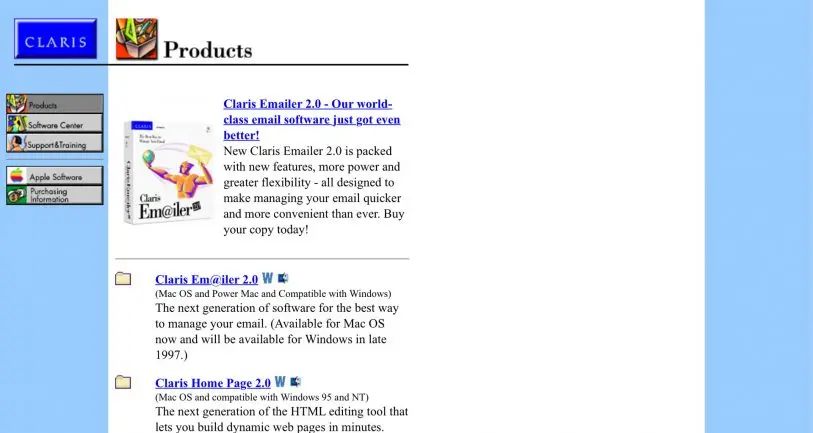Two decades ago, Apple was a troubled company in a time of upheaval. Cofounder Steve Jobs, who had officially returned as interim CEO in September 1997, had a plan to return it to health. And a big part of his strategy involved abandoning an array of efforts that he didn’t deem essential.
Among the businesses that Apple wound down were most of the activities of Claris, an 11-year-old subsidiary that offered a full portfolio of productivity applications for both Macs and Windows PCs, including ClarisWorks, ClarisDraw, Claris Organizer, and more. In January 1998, Apple laid off 300 Claris staffers and turned the remnants into FileMaker, a much smaller operation focused on the cross-platform database software FileMaker Pro.
The downsizing was controversial at the time, but worked out well. Third-party developers provided Macs with the productivity software they needed (including Microsoft, which had invested $150 million in Apple and committed to continued investment in Office for the Mac the previous August). And FileMaker, though a tiny, low-profile part of the Apple empire, has been a consistently successful one, racking up more than 80 back-to-back quarters of profitability. Today, it has a million users at 50,000 companies, including many small- and medium-sized businesses but also 95% of the Fortune 500.
Now FileMaker is ready to broaden its horizons past its namesake database. The fact that it’s coupling this expansion with a corporate rebranding isn’t particularly surprising. But I wouldn’t have guessed the new name it’s announcing at its annual developer conference: FileMaker is going back to being Claris.
Though the revival of the Claris moniker after 21 years of limbo is a nod to FileMaker’s heritage, it isn’t a nostalgia play, says Brad Freitag, the six-year veteran of FileMaker’s sales organization who was named CEO in March. After all, customers in their thirties might not even remember the brand’s last go-around. Instead, the old name felt right all over again, based on the qualities it conveys rather than its history.
“As we played with probably a thousand naming considerations, we continued to return to Claris as a name,” explains Freitag. “We liked that it was short. It speaks to clarity, shining the light, illumination. We felt like it really expressed our brand well.” For those of us who do remember the previous Claris brand—created by legendary Silicon Valley figure Bill Campbell—the fact that it’s returned is a delightful Easter egg.

Beyond the database
In recent years, the company that will now be known as Claris has been busy reimagining FileMaker—a product whose roots date to the early 1980s, when its predecessor was a DOS program originally known as Nutshell—for the modern, cloud-first age. The classic FileMaker Pro software for Macs and Windows isn’t going anywhere, but FileMaker is now a full-blown platform, with the option to host databases in the cloud using Amazon’s AWS service and reach them from iPhone, iPad, and browser-based versions of the software. The competition isn’t other database packages—even Microsoft Access, FileMaker’s longtime archrival—but any tool set that allows businesses to build custom in-house applications. FileMaker’s goal is to be easy enough to use that employees without a technical background can do the building.
Even before the Claris rebrand, FileMaker has been calling itself a “workplace innovation platform,” a category with more elbow room for fresh opportunities than “database.” Along with its new name, it’s formally announcing an acquisition it made with this more expansive mission in mind. Earlier this year, it purchased Stamplay, a Rome-based company that specializes in simplifying the shuttling of data between services such as Box, Mailchimp, Salesforce, and Slack. (In March, there were reports that Apple had bought the company, though they didn’t figure out FileMaker’s role in the deal—perhaps a sign that even professional Apple watchers have been prone to overlook the subsidiary.)
Owning Stamplay helps solve an obvious problem for FileMaker users who likely have corporate data salted away in a variety of cloud services. “We’ve had FileMaker integration for a long time, but there was a level of scripting involved that made it less accessible to a lot of our problem-solvers,” says Freitag. “And this will make integration between FileMaker and other services far more accessible to a broader development community.” Under the new name Claris Connect, Stamplay’s technology will also be available for integration tasks that have nothing to do with FileMaker databases, giving Claris access to customers whom it might never have reached in the past.
Asked why Apple has continued to find value in FileMaker—I mean Claris—for all these years, Freitag seems to take pains not to speak on behalf of the parent company. But he does talk about why the subsidiary’s long-standing focus on helping nontechnical people streamline business processes has remained relevant. “Packaged apps really matter, and they do great things for us,” he says. “But I think every business has unique IP. And to the extent we can transition that into a digital scope, it makes a lot of sense. There are some secrets we’ve unlocked there.”
Even with a new corporate name, new products, and an ever-increasing emphasis on the cloud, the business Freitag leads is recognizable as the one Apple found worth preserving back in 1998. But he does have one other goal for the new Claris: “I think we’d like to go from being quietly successful to being visibly successful.”
Recognize your brand’s excellence by applying to this year’s Brands That Matter Awards before the early-rate deadline, May 3.
